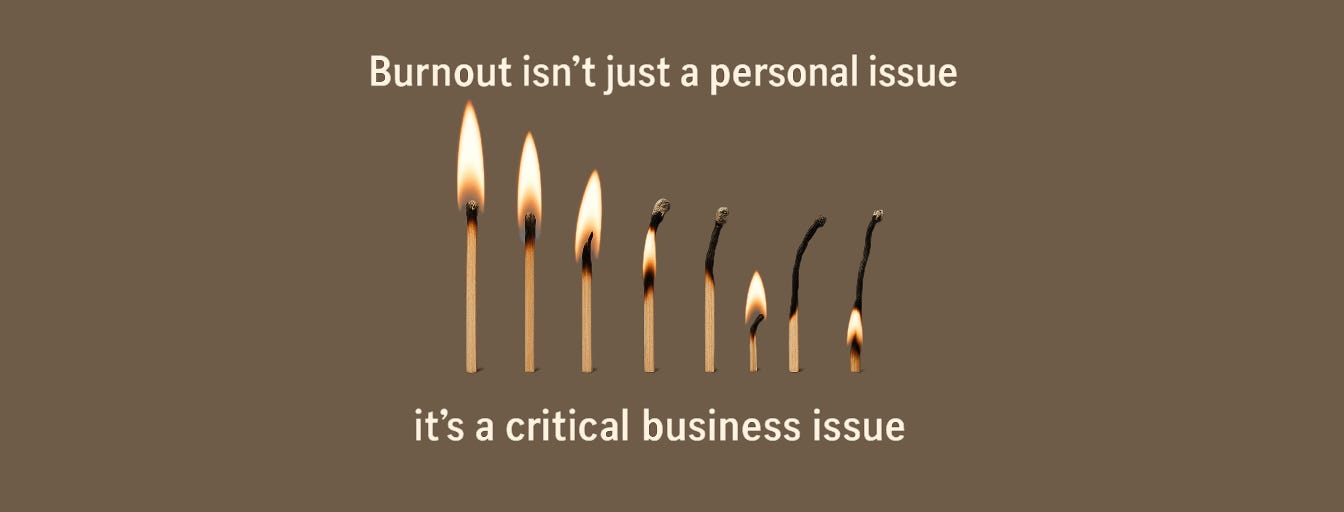Restoring Burnt-Out Talent: Causes and Consequences
Executive Insights Digest #25: Restoring Burnt-Out Talent Part One
Burnout has become alarmingly common in today’s high-pressure workplaces. In the tech sector alone, 43% of employees report high levels of daily stress, and up to 61% feel on the verge of burnout at any given time. One survey of IT professionals across 33 countries found two in five tech workers at high risk of burnout due to long hours and intense workloads. For leaders, the stakes are just as high; executive burnout has surged from a rarity to a widespread challenge, funneling stress downward through entire organizations. In short, burnout is everybody’s problem in a high-performance environment.
Burnout is more than just “working hard” or feeling tired. The World Health Organization defines burnout as an “occupational phenomenon” resulting from chronic workplace stress that has not been successfully managed. It manifests in three hallmark symptoms:
Exhaustion – feeling physically and emotionally drained,
Cynicism or detachment – losing enthusiasm and becoming negative or callous toward work,
Reduced efficacy – declining performance or sense of accomplishment.
In other words, a burnt-out employee is like a match that has burned brightly but now has nothing left to give – the flame of productivity extinguished. This syndrome can creep up on anyone, from frontline developers to C-suite executives. It is often cumulative, building up over relentless cycles of stress with insufficient recovery, until the individual hits a breaking point.
Burnout is especially pernicious in high-stakes industries such as video game development and tech startups. These fields thrive on passion, creativity, and intense dedication – traits that top performers and leaders typically have in spades. However, the same fire that fuels high performance can, if unmanaged, consume the individual.
Company cultures in gaming and tech sometimes glorify overwork: “crunch time” has long been accepted as “a normal part of the development process”, with employees implicitly told that making games or launching a new app should be its own reward. In practice, this mentality has teams of developers pulling 12+ hour days for weeks on end, often without adequate rest or compensation. The result is predictable – exhausted teams creating products under suboptimal conditions.
In tech startups, a similar “hustle culture” prevails, where founders and engineers feel constant pressure to “move fast” and work nights and weekends to outperform the competition. Such environments carry a hidden cost: the very talent driving the innovation can flame out, leading to errors, delays, and departures.
This article series is a comprehensive guide for leaders, especially in the gaming and IT sectors, on how to restore a burnt-out employee and also recover yourself as a leader. In the first article:
We will examine why addressing burnout is so important, not only for employee well-being but for business performance and the bottom line.
Next, we’ll explore why our top performers and we as leaders are susceptible to burnout, identifying the high-pressure demands and systemic factors in tech and gaming that can push even the best to their breaking point.
In the second article:
We dive into proven methods, models, and tools for burnout restoration, emphasizing evidence-based practices that work in high-performance, high-stakes contexts.
Finally, we provide a detailed, step-by-step “DIY” recovery plan that you can start implementing as early as tomorrow, complete with actionable takeaways, templates, and practical tips.
Our goal is to equip you with both the strategic insight and the concrete applications needed to tackle burnout head-on. High performance and high well-being do not have to be mutually exclusive. By proactively restoring burned-out team members (and taking care of yourself), you can reignite the passion, creativity, and productivity that drive success in gaming and tech, while building a sustainable culture where your people can thrive long-term.
Why It Is Important
Burnout isn’t just a personal issue – it’s a critical business issue. When even a single key contributor is burned out, the ripple effects on team performance and morale are profound. When burnout becomes widespread, the organization as a whole suffers serious consequences. Due to the unpleasant consequences below, every leader should treat burnout prevention and recovery as a top priority.






